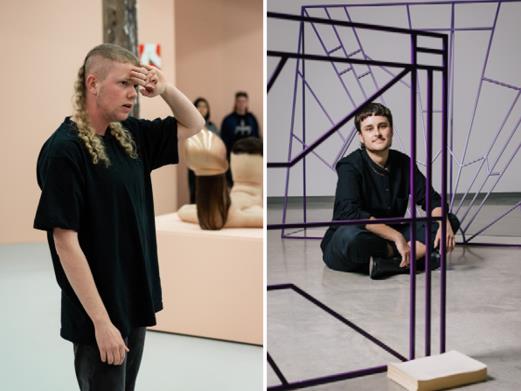(L-R) Archie Barry, Hypnic, performance approximately four minutes. Fifth rendition, Artspace Sydney, 26 September 2018. Spence Messih, Primavera: Young Australian Artists 2018, Museum of Contemporary Arts, Sydney. Photos by Jacquie Manning.
Written by artists Spence Messih and Archie Barry, Clear Expectations is a new best practice resource which aims to educate institutions, galleries and curators on how to best support trans, non-binary and gender diverse people in art spaces and workplaces.
Supported by Countess, a data collection survey of gender representation in the Australian art sector, and the National Associating for the Visual Arts (NAVA), Clear Expectations aims to address ‘various issues including the commodification of personal identity, the tokenisation of work, having the complexity of one’s practice be reduced to a gender-centric reading and witnessing the erasure of gender diversity in broader gendered contexts.’
Esther Anatolitis, Executive Director of NAVA, told ArtsHub: ‘Anyone who offers a platform, works in an organisation or sits on a board should sit down with colleagues and collaborators and work through this excellent resource.
‘Archie and Spence offer clear and useful guidelines on our individual and organisational responsibilities, from everyday communication to career development to when to engage specialist, paid consultation by trans, non-binary and gender diverse people. Take the time to read it through as a group and discuss exactly how you’ll apply its guidance,’ she urged.
The guidelines cover important subjects such as: pronouns and misgendering; respecting privacy; inclusion as the curatorial framework; creating a safer environment; inclusive labelling practices of bathrooms, and more.
Co-authors of the guidelines, Messih and Barry said in a statement: ‘Experiencing harm from the bureaucracy of institutional decision-making is a common experience for trans, non-binary and gender diverse people, even in the Australian arts sector.
‘Institutions, galleries and curators often fail to respect and affirm the gender identities of trans, non-binary and gender diverse people – this is particularly alarming as institutions often engage with this community of people to represent their gender identities.’
Shaped by both authors’ lived experiences, the guidelines acknowledge that ‘the resource will be unable to address all situations, as the art world, gender and language are constantly changing constructs’. However, it is hoped that such best practice guidelines will create much more inclusive art spaces and workplaces in the future.
Clear Expectations is now available as a free download and can be accessed via the new Countess website, www.countess.report






